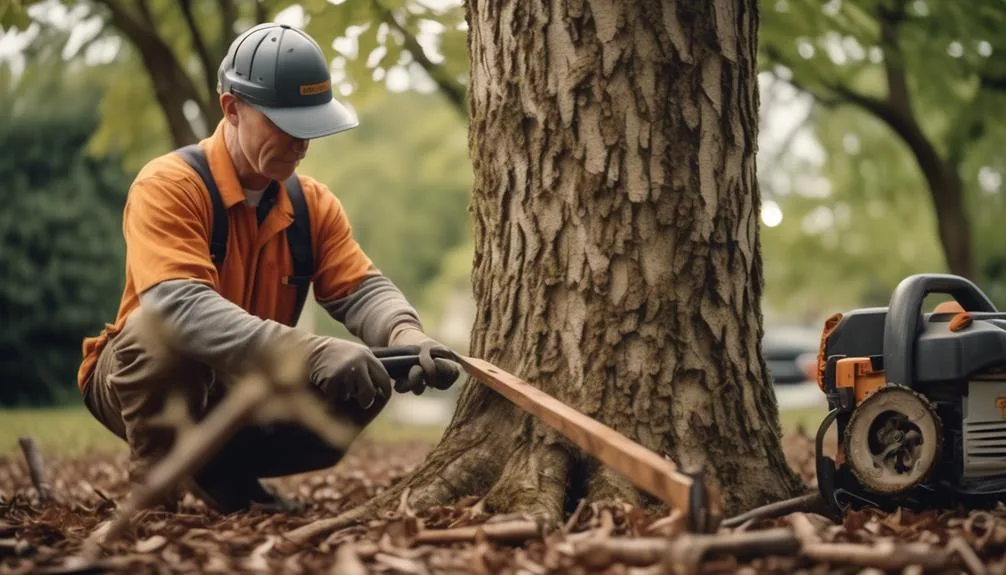Caring for a hickory tree can be quite demanding. Regular pruning, managing pests, and dealing with diseases require attention and effort.
Is it really that labor-intensive, or are there simpler ways to ensure a healthy tree? Let's explore the various aspects of hickory tree care to find out.
Pruning and Trimming
To maintain the health and appearance of your hickory tree, regular pruning and trimming are essential. Understanding the growth patterns of your hickory tree is crucial for effective pruning. Hickory trees typically have a central leader with lateral branches, so it's important to prune to maintain this structure.
Equipment needed for pruning and trimming includes sharp bypass pruners for smaller branches, loppers for thicker branches, and a pruning saw for larger limbs. It's also important to have protective gear such as gloves and safety glasses.
When pruning, focus on removing dead, diseased, or crossing branches to improve air circulation and sunlight penetration. Additionally, trimming should be done to remove any unwanted growth or to shape the tree as desired.
Regular maintenance through pruning and trimming will keep your hickory tree healthy and looking its best.
Fertilizing and Watering
Maintaining the health and appearance of your hickory tree requires proper fertilizing and watering to complement your regular pruning and trimming routine.
Start by conducting a soil test to understand the nutrient composition of the soil around your tree. Based on the results, you can implement a nutrient management plan to ensure that your hickory tree receives the necessary nutrients for healthy growth.
When it comes to watering, consider efficient irrigation techniques to provide adequate moisture control. Deep, infrequent watering is often beneficial as it encourages the development of deep roots while reducing water evaporation.
Mulching around the base of the tree can also help retain soil moisture.
Pest and Disease Management
Implementing proactive pest and disease management measures is crucial to safeguarding the health and vitality of your hickory tree. To effectively manage pests and diseases, consider the following:
- Integrated Pest Management (IPM)
- Encourage natural predators: Introduce beneficial insects or birds that can help control pest populations.
- Monitor regularly: Keep an eye out for any signs of pest infestations and take action as soon as possible.
By implementing IPM practices, you can minimize the use of chemical pesticides while effectively managing pests.
Additionally, consider the following disease prevention strategies:
- Disease Prevention Strategies
- Prune properly: Regularly prune your hickory tree to remove diseased or dead branches.
- Choose disease-resistant varieties: When planting new hickory trees, opt for varieties that are known to be resistant to common diseases.
Harvesting and Nut Collection
Safeguarding the health and vitality of your hickory tree through proactive pest and disease management sets the stage for a successful harvesting and nut collection process. Once the nuts are ready for harvest, it's important to process and store them properly. Hickory nuts can be enjoyed fresh, but they can also be stored for later use. Proper storage helps maintain their flavor and quality. Additionally, wildlife interactions can impact the nut collection process. Squirrels, birds, and other animals are attracted to hickory nuts and may compete with you for the harvest. It's essential to be mindful of wildlife and take steps to protect your nuts from being consumed by animals. Setting up physical barriers or using deterrents can help safeguard your nut harvest.
| Nut Processing and Storage | Wildlife Interactions, Impact |
|---|---|
| Process nuts for freshness | Be mindful of wildlife |
| Properly store for later use | Protect nuts from animals |
Overall Maintenance
Regular pruning and inspection of your hickory tree ensures its health and longevity. This maintenance task helps to identify and address any issues early on, promoting the tree's overall well-being.
As for seasonal care, it's essential to fertilize the soil around the hickory tree in the spring to support healthy growth. Additionally, mulching the base of the tree during the summer months helps retain soil moisture and regulates soil temperature, benefiting the tree's root system.
When it comes to soil health, regular soil testing can provide valuable insights into any deficiencies or imbalances, allowing you to make informed decisions about amendments.
Conclusion
In caring for a hickory tree, dedication and hard work are essential for its overall health and vitality. Regular maintenance, including pruning, fertilizing, and pest management, is crucial.
The effort put into harvesting and nut collection is rewarded with the beauty and benefits of a well-cared-for hickory tree.
How will you dedicate yourself to the care of your hickory tree?
Mark Hoffman is a dedicated arborist and tree care specialist with over a decade of experience. His love for trees began when he visited Yosemite National Park as a teenager and was awestruck by the giant sequoias. Mark pursued his passion by studying forestry at Michigan Technological University, where he earned a Bachelor of Science degree.
Since then, he has worked tirelessly in the field of arboriculture, helping to preserve and protect trees in his community. His expertise and dedication have made him a respected leader in the industry and a valuable resource for anyone seeking advice on tree care.
